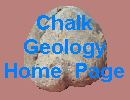
Working on the geology of the chalk is not easy - it is all white and not as instantly rewarding as other strata. Members of the Hull Geological Society have had an interest in the topic since its earliest years.
G W Lamplugh lived at Bridlington and studied the local rocks. He is perhaps most famous for his work on the Speeton clay, but he did measure the coastal sections of the Chalk and published their stratigraphy in 1895. He went on to become a professional geologist, eventually becoming the Director of the geological Survey and a fellow of the Royal Society.
D W Toyne started to carry out fieldwork on the inland exposures, but was killed in a motor cycle accident in 1935. His collection and notebook were given to the young Ted and Willy Wright. Tom Sheppard, Curator of Hull Museums, encouraged their interest in the Chalk. One of their first important finds was a starfish at Dane's Dyke. Robert Stainforth told me that it was actually found by their mother when having a picnic, apparently she thought it looked like a set of false teeth. They published a paper about a large variety of fossils found under a large ammonite at Kiplingcotes Station Quarry. Ted and Willy continued Toyne's work and concerned that they may not survive the war published an incomplete report in 1942. After the war Willy worked in London and continued his amateur research into chalk fossils, publishing memoirs on ammonites and echinoids. Ted returned to Hull and worked (I think) for Reckitt and Coleman and became an (amateur) expert on marine archaeology. They did not continue their studies of the Yorkshire Chalk. They both received honorary degrees from the University of Hull in 1987.
The Hull Museums geological collections were destroyed by incendiary bomb in 1943. Including the large collection of chalk fossils purchased from the Mortimer Museum in Driffield. By 1970 members of the Society were concerned about the lack of geology in the Museum and Percy Gravett reprinted copies of the Wright brothers' 1942 paper to start a project to create a new collection of Chalk fossils.
Felix Whitham, the Treasurer of the Hull Geological Society, had a long interest in the Chalk and in 1984 proposed the stratigraphy of the Yorkshire Chalk and the creation of a collection of Chalk Fossils as the topic for the Society's Centenary Project. A group including Lynden Emery, Donald Beveridge, Tony Gear, Dave Finer, Mavis May, Felix and myself started to visit quarries and coastal exposures, logging the beds and collecting fossils. The plan was to give the fossils to the University of Hull Geology Department, but its closure was announced in 1988, the Centenary year! In response to a request for help in the Geologists' Association Circular Professor Malcolm Hart suggested that we collect samples for he microfossils. That is where my interest in micropalaeontology and fine scale stratigraphy began. Specimens from the collection were exhibited at the Centenary Meeting in 1988 and Felix published the lithostratigraphy and biostratigraphy in 1991 and 1993. He received an honorary degree from the University of Hull for this work in 1992.
Bibliography of the Yorkshire Chalk

